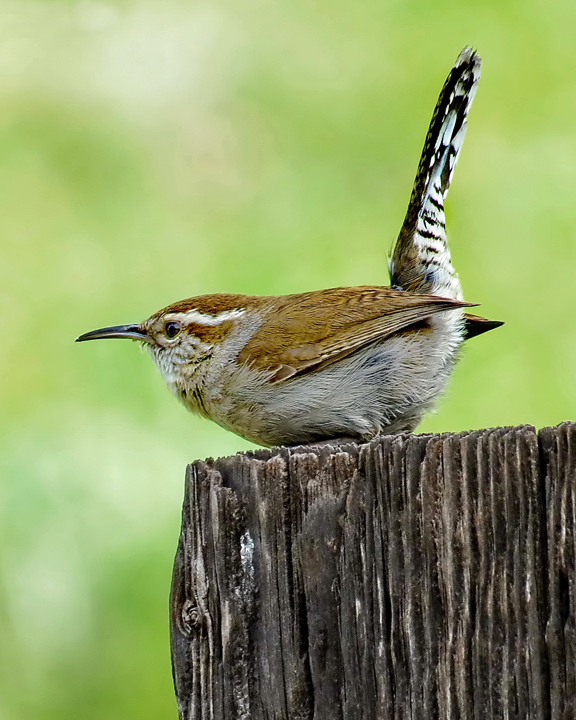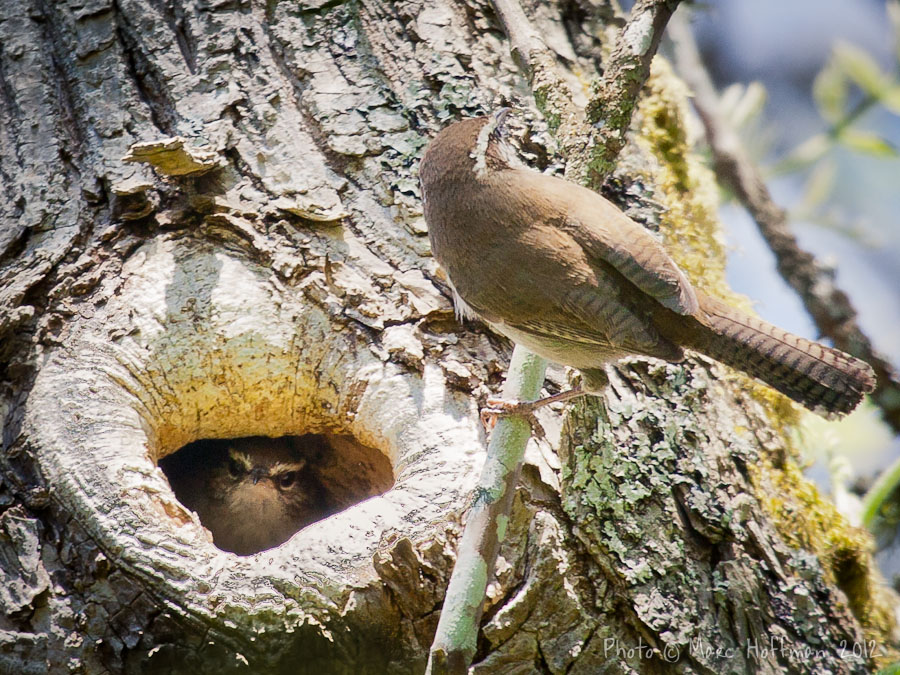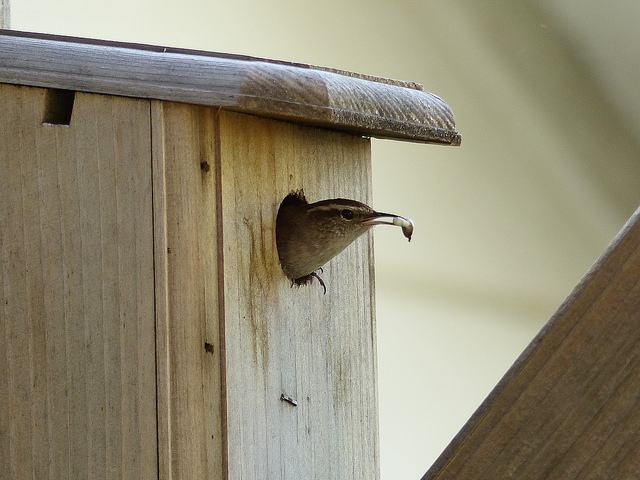Soundclip 1) A variety of whistles and songs from the Bewick’s Wren (Robert Mortensen, 2013).

Figure 1) A Bewick’s Wren perched atop a dying ocean spray (Holodiscus discolor). Neck Point Park, Nanaimo, B.C. (Photo by Braden Judson).
The Bewick’s Wren (Thryomanes bewickii) is a small, noisy and agile bird inhabiting dense underbrush and open woodlands throughout Western North America (Figure 1) (Kennedy ED and White DW, 2013). In 1821 the bird painter John Audubon was the first to identify a specimen of the bird; who would then name the species after his companion and fellow artist Thomas Bewick (Cornell University: All About Birds). The Bewick’s Wren is distinguished from other wren species due to a long and white eyebrow, a down-curved and slender bill, and a lengthy, nearly vertical tail decorated with dark bars and pale spots. The Bewick’s Wren is a dark species of wren with a deep coffee-brown body and a pale gray underside. Both males and females demonstrate similar plumage and are difficult (or impossible) to tell them apart (Kennedy ED and White DW, 2013).
Soundclip 2) A disturbed Bewick Wren’s buzzing alarm call (Macdonald G, 2014 – Spokane River, USA).

Figure 2) A posing Bewick’s Wren, displaying features like a vertical and striped tail, downward curving bill, white eyebrow and gray underside (Winning E, 2012).
While these features are distinct and recognizable, the Bewick’s Wren (like most wrens) are often hidden by thick brush and vines; making for sometimes tricky identification. Aside from hearing the wren traverse through their dense habitat, the Bewick’s Wren exhibits a phenomenal diversity of calls, songs and buzzes (I discuss their variation in song in my second blog post). Bewick’s Wrens are notoriously noisy birds, with some males demonstrating up to 16 unique calls (Schroeder E, 2017). During their mating season these wrens will produce an elaborately complex and beautiful song (Soundclip 1). In additional to a song, the Wren will display and shake their tail feathers to catch a potential mate’s attention (Ortega-Welch, 2017). A variety of quick chirps and warbling swoons can be heard throughout the year in addition to an irritated buzzing sound. The wren will erupt in a series of deep, mechanical buzzes when defending their territory from other males or competing species (Audubon). The wren’s extreme diversity of calls drives specific and choosy mate selection as well as competition between males to produce better quality songs. Often it’s the older males who have perfected their spring songs and are rewarded with better mates and nesting habitat.
With short wings and a long, stiff tail the Bewick’s Wren is well suited for manoeuvring through dense, tangled vegetation. Wrens are passerines, meaning that their feet and body shape are adapted for perching on branches, twigs, etc. The Bewick’s Wren is often seen hopping and gliding between shrubs in the undergrowth of forests; rarely being observed flying or perching in trees/tall vegetation. The wren’s foraging and nesting habits reflect this species close association with the forest floor (Cornell University: All About Birds). The Bewick’s Wren is a cavity nester; meaning that this species constructs nests in pre-existing hollows such as rock crevices, wood-pecker holes and rotting trees or logs. The wrens use natural, soft materials such as reeds, hair and moss to construct a small, cup-shaped nest in their cavity of choice. A female wren can deliver a clutch of 3-8 eggs, and under optimal conditions produce two clutches in a year. With the oldest Bewick’s Wren ever recorded being 8 years of age, members of this species have a good reproductive potential over their lifespan (Cornell University: All About Birds).

Figure 3) A pair of Bewick’s Wrens cooperatively building a nest in the naturally occurring crevice of a Cottonwood Tree (Populus sp.) (Hoffman M, 2012).
However adaptable the Wren might be, it’s success is threatened by several major factors. The Bewick’s Wren’s preferred, densely vegetated habitat is routinely removed and reduced by urban encroachment. Land clearing activities alter the natural succession of vegetation and result in areas that are too exposed for the Wren. In addition to losing habitat, the competition for nesting sites has dramatically increased with the presence of new, cavity nesting species such as the European Starling or the Eastern House Wren (Kennedy ED and White DW, 2013). Climate change, urban sprawl and introduced species have caused the ranges of many cavity nesting species to overlap and has resulted in the Bewick’s Wren having to work much harder to produce offspring. On the easternmost range of the Bewick’s Wren habitat is competition the fiercest, with House Wrens parasitizing nests, destroying eggs and competing for food. The eastern Bewick’s Wren is a conservation priority due to its annually declining population, however the western population has been relatively stable over the last decade. There are approximately 6.1 million Bewick Wrens across North America, giving the species a continent-wide status of low-concern (Partners in Flight, 2017).
Conserving this species of Wren involves maintaining adequate food and habitat. The Bewick’s Wren’s diet is primarily composed of invertebrates (insects, spiders, larvae, etc) with some seeds and berries. The brambly habitat of the Wren supplies abundant insects, with the wren often scratching through dead leaves and twigs in search of its next meal. The Wren opportunistically forages on mixed seeds and berries for essential vitamins and minerals; especially throughout the winter when insects are scarce (Cornell University: All About Birds). Thickly vegetated areas not only provide food, but shelter too. Living in thick vines and prickly plants is often enough to deter any predators from pursuing the wren and keeps curious animals away from their nest sites. Under opportune circumstances the Bewick’s Wren is predated on by cats, snakes and raptors. In dense brush the Bewick’s Wren is built for agility and can often escape unharmed, however in exposed habitat the Wren’s short wings make it slow and susceptible to attack. Ensuring that there is sufficient shrub habitat is a critical step in conserving this species. Other factors such as keeping cats indoors and limiting insecticide (insect-killing chemicals) usage will reduce predation pressure and sustain their primary food source. If you wish to play a part in preserving this species around your house, you can install nest boxes (nest boxes without perches will ensure competitors such as the European Starling will not take nest!) and plant native shrubbery and willows (Washington Post, 2011). The Bewick’s Wren will reward your generosity by providing your neighborhood with a both melodious and bizarre range of songs throughout the year.

Figure 4) A mother Bewick’s Wren removing waste from an occupied nesting box (Robeson B, 2017). Notice how there is no perch on the face of the box; this ensures only cavity nesting birds can establish a nest and reduces competition between them and other species, such as the European Starling.
Literature Cited
1) Audubon Guide to North American Birds (Internet). [Cited 2017, September 16]. Available from: http://www.audubon.org/field-guide/bird/bewicks-wren
2) Cornell University: All About Birds (Internet). Bewick’s Wren. [Cited 2017, September 19]. Available from: https://www.allaboutbirds.org/guide/Bewicks_Wren/sounds
3) Eric Schroeder. 2017. The Boldness of Bewick’s Wren. Bay Nature Magazine (Internet). [Cited 2017, September 19]. Available from: https://baynature.org/article/boldness-bewicks-wren/
4) Kennedy ED and Douglas WW. 2013. Bewick’s Wren (Thryomanes bewickii), The Birds of North America (P. G. Rodewald, Ed.). Ithaca: Cornell Lab of Ornithology; Retrieved from the Birds of North America. doi: 10.2173/bna.315
5) Marissa Ortega-Welch. 2017. Learn Your Local Birds ‘Regional Accents’. Audubon (Internet). [Cited 2017, September 16]. Available from: http://www.audubon.org/news/learn-your-local-birds-regional-accents
6) Partners in Flight (Internet). 2017. Avian Conservation Assessment Data Base, 2017 Update. [Cited 2017, September 16]. Available from: http://pif.birdconservancy.org/ACAD/Database.aspx
7) Washington Post (Internet). 2011. House wrens: Success in the city. [Cited 2017, September 16]. Available from: http://www.washingtonpost.com/wp-srv/special/metro/urban-jungle/pages/110405.html
This was very informative and well written! Do wrens stay in the same nest cavity throughout their lives? Or do they make a new one annually? They seem to put quite a bit of work into constructing them.
^^ This is Christina by the way! Dang student numbers.
As far as I know, they will use a nesting site for as long as they can. They usually have monogamous relationships and will nest in a site every year if possible. However, if the nest site is damaged or disturbed (most commonly overtaken by invasive cavity-nesting species) they will have to rebuild! I know some blogs I looked at had backyard nests for the Bewick’s Wren and have observed a couple of wrens going in and out of a single bird house for many years.
This was a very interesting read and I really liked the information you provided on helping with their conservation! Do you know of any strategies that the Bewick’s wren use in fending off their competitors, such as the House wren?
https://www.youtube.com/watch?v=zc6mxaiBAJ4
This video shows how species such as the House Wren indirectly compete through methods of sabotaging nests. Most of the competition they experience is by nest parasitising and other birds killing their eggs. Unfortunately, there’s not a lot they can do about this because both the male and female Bewick’s Wren actively forage while their eggs are in the nest. When directly faced with a competitor, they do a dance where they expand their tail retrices as wide as they can to make themselves appear larger than they are, and produce a deep and harsh buzzing sound (can’t find a video unfortunately). While this is usually somewhat efficient at deterring the House Wren, other nest/food competitors (such as the much larger, European Starling) are less deterred by their displays.
Great blog – well detailed and nice visuals. Wrens are bad ass! There are quite a few examples of wrens destroying each other’s nest. I hadn’t seen this video – don’t leave your eggs unattended. One would expect a squirrel to attack, not so much a wren.